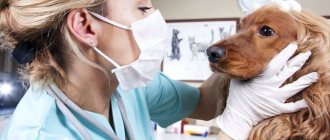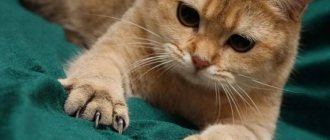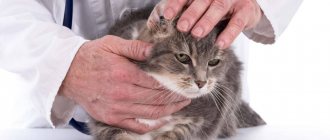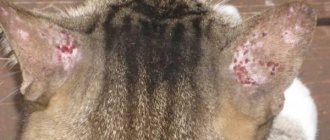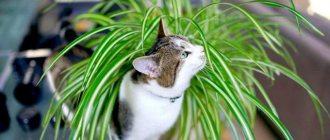Diabetes mellitus in cats is a common and fairly common endocrine disease; in this disease, the animal’s body is not able to properly monitor the amount of glucose in the blood and its metabolism. At the same time, insulin production decreases or tissue cells become resistant to its action. And partial or complete insulin deficiency is the cause of persistent hyperglycemia, which characterizes feline diabetes mellitus.
In general, a cat is a different animal from a dog and is more sensitive to stress, which can cause blood glucose levels to rise, although this does not mean that the cat necessarily has diabetes, but only temporary hyperglycemia. When the cat calms down, this phenomenon goes away. Therefore, sometimes when taking blood in a clinic, where every pet can be very worried, sugar may turn out to be elevated, and such a case always requires further clarification.
Causes of diabetes in cats
Any cat can get diabetes, regardless of breed or gender. Data have been established and published in the literature according to which castrated cats are approximately 2 times more likely to develop diabetes mellitus than sterilized cats. This is argued by the fact that cats have a higher risk of developing obesity, higher insulin concentrations and lower sensitivity to it. Insulin is a special hormone that is secreted by the pancreas. Once in the blood, it transfers glucose to the organs and tissues of the body, and each cell of the body thus receives nutrition and energy. But the disease itself develops, manifests itself and proceeds in the same way in both sexes, and diabetes mellitus in cats has absolutely the same consequences and complications as in cats. And obesity is in any case the main predisposing factor.
Treatment control
Throughout the entire period of treatment for diabetes, it is necessary to monitor the blood sugar level of a sick cat. This can be done using a glucometer. The owner keeps a special journal in which he records the dosage and time of injection, as well as the date, time and device readings.
Using these records it will be convenient to track the dynamics of treatment.
Even after recovery, you need to regularly monitor your sugar levels. In order not to expose your cat to unnecessary worries when visiting the clinic, you can purchase special test strips. They are sold in every veterinary pharmacy.
Expert opinion
Chepa Natalya Semenovna
Veterinarian
Ask a Question
Among cats, fold-eared breeds are most prone to otitis, because... they have a small closed ear and a narrow ear canal that is poorly ventilated. Hairless breeds produce a lot of sulfur, which can also be a predisposing factor for the development of otitis media. A common mistake owners make when caring for their ears is using a cotton swab. It will not be possible to clean the ear well with a cotton swab due to its structure, but leaving the cotton swab, “compacting” the wax inside the passage and causing irritation of the skin of the ear canal is quite likely. For home care, it is best to use special lotions no more than once a month. You should not use multi-component ear drops on your own. Medications should be prescribed by a doctor based on a cytological examination.
Types of diabetes in cats
Animals have a classification of diabetes mellitus, but in cats it is more conditional than in humans. Since in most representatives of this species it is impossible to accurately determine the type of this disease, insulin administration is most often used for treatment, regardless of the reasons for the development of the pathology. However, there are three types of diabetes mellitus in cats:
- insulin-dependent diabetes mellitus (type I)
- non-insulin-dependent diabetes mellitus (type II)
- secondary diabetes (type III)
The first type of diabetes mellitus can occur at any age and requires regular lifelong use of insulin, otherwise the animal will die. Often cats with this type of diabetes are thin, and sometimes complications such as ketoacidosis occur.
More diabetic patients have type 2 diabetes. They are usually over 7 years of age, overweight or normal weight, with decreased sensitivity to insulin. Without insulin therapy or skipping an injection, these cats do not die and usually do not develop ketoacidosis. But to improve the quality of life and reduce the negative impact of excess glucose on the organs of the body, such patients can also be treated with an insulin drug.
The third type includes diabetes provoked by a primary disease - these are pathologies that directly affect the pancreas: pancreatitis, neoplasm (usually adenocarcinoma of the gland), endocrinopathies: hyperadrenocorticism, hyperthyroidism, acromegaly. The introduction of some diabetogenic drugs can cause the development of the disease - glucocorticoids, progesterone. When the underlying cause is addressed, secondary diabetes may resolve, and sometimes cats also require lifelong insulin therapy, but insulin doses are often required quite high due to the development of resistance to the hormonal drug administered.
Diabetes mellitus in a sick cat may be uncomplicated, with no increase in ketone bodies in the blood (ketonemia), no metabolic acidosis, and, accordingly, no coma or stupor. This form can also be called transient. And the lack of timely diagnosis or necessary treatment will lead to a complicated form of the disease - ketoacidotic diabetes mellitus or hyperosmolar non-ketoacidotic diabetic syndrome. The latter is rare.
What you need to know about the disease
Feline diabetes is a disease similar to humans. It has similar causes and clinical picture.
Why diabetes is dangerous
Without timely treatment, the disease leads to sudden weight loss, dehydration, problems with motor function, coma and death. The danger of the pathology is that it is detected late. By the time cats are diagnosed, they are usually already severely insulin dependent.
Risk group
Animals suffering from obesity and inflammation of the pancreas are at particular risk. There is no clearly defined age category for cats with diabetes. Although it has been noted that most often the disease occurs in middle-aged and elderly pets. The disease is more common in cats than in cats.
Symptoms of diabetes in cats
Diabetes mellitus in cats will have signs and symptoms depending on the form of the disease. But, of course, the most common symptom is increased thirst (polydipsia) and, as a result, polyuria appears. At the same time, more urine is produced, and the cat begins to urinate more often and more volume, and the urine itself becomes lighter, more transparent and contains glucose, so sometimes the first sign that the owner notices is sticky marks from the pet’s paws on the floor or other surfaces in the apartment. Also, with uncomplicated diabetes, there may be an increase in appetite (polyphagia). But, despite an increased or normal appetite, the animal begins to lose weight.
If the owner does not attach importance to these manifestations, then the pet’s condition will gradually worsen. This generally occurs over a period of a couple of weeks to many months, and can take a year in some cats. Then weakness, lethargy, vomiting appear, diarrhea, changes in gait, and unsteadiness are possible.
How common is the disease?
No one has conducted studies on the incidence of diabetes mellitus among cats, so there are no official statistics on this issue.
However, it is safe to say that the number of sick animals is steadily growing. This is due to an increase in the number of pet cats that are overweight or obese.
Diabetes mellitus ranks first among endocrine diseases in terms of incidence. Anecdotal evidence suggests that one in 400 domestic cats is diagnosed with diabetes.
Often owners feed their pets and do not care about their physical activity. They are touched by a plump kitten; they do not think about the fact that by the age of 5–6 years he will acquire the status of a diabetic.
Important! In small breed cats, exceeding the standard weight by more than 1.5 kg is considered obese. They will not be allowed to do breeding work, and they will fall into a health risk group.
With age, the likelihood of developing diabetes increases significantly. It is important to pay increased attention to older pets so as not to miss the opportunity to correct their health condition.
Diagnosis of diabetes mellitus in cats
The pet owner himself may suspect such a disease, but only a veterinarian can confirm the diagnosis. Unfortunately, in most cases, the animal does not arrive at the clinic at the primary stage of the disease. And although in such a situation, diabetes mellitus in cats has quite characteristic symptoms, it is imperative to carry out a comprehensive diagnosis, otherwise it is impossible to identify all the complications that have developed and stabilize the patient by providing proper assistance.
First of all, the doctor will conduct a clinical examination of the patient. In this case, it is possible to identify changes in the coat: dandruff, dull wool, stuck together in tufts; as well as obesity or exhaustion, dehydration, hypothermia, depression, muscle wasting, plantigrade gait. Next, in all cases, blood is taken for biochemical, general clinical and thyroid hormone analysis, a urine test is prescribed, ultrasound diagnostics of the abdominal organs is performed, and, if necessary, a cardiological examination. The results of all these studies will allow us to determine the type of diabetes and choose the appropriate treatment for each individual patient.
Diagnostics
Diabetes mellitus cannot be diagnosed based on symptoms alone, as they can be common to different diseases. The doctor may prescribe a variety of tests, here are some of them :
- general blood analysis;
- Ultrasound;
- blood chemistry;
- urine test.
In some cases, diagnosis includes a glucose tolerance test. Express urine testing using special sugar-sensitive strips is often used.
Treatment of diabetes mellitus in cats
After confirmation of the diagnosis, the treatment plan is already determined by the veterinary endocrinologist. Of course, diabetes mellitus in cats is treated depending on the type of disease. In the case of a complicated form of the disease, hospitalization of the animal is necessary, and in a hospital setting, primary rather intensive therapy is carried out - infusion of drugs and insulin injections, and a special scheme of frequent administration of short-acting insulin is used, and the dose is low, necessary only to relieve ketoacidosis. And only after the condition improves and the level of ketones in the blood normalizes, the doctor selects the required type of insulin, the active substance of which may have a different duration of action. For these purposes, the doctor usually draws up a so-called sugar curve. Whatever insulin is used, cats require insulin injections every 12 hours (there are no daily insulins available for cats yet). The necessary symptomatic treatment is also prescribed according to the identified concomitant pathologies.
If uncomplicated diabetes mellitus is present, then, depending on the expected type of diabetes, treatment with diet therapy in combination with insulin or oral medications is chosen, but most medical hypoglycemic tablet forms are not used in cats due to their hepatotoxicity and short-term effect. And if a primary disease is identified, then the necessary drugs are selected to correct it.
Nutrition is a major part of therapy for sick, overweight animals. Reducing body weight is considered one of the main conditions necessary for a positive result in the treatment of diabetes, due to the fact that with a decrease in the volume of adipose tissue in the body, the sensitivity to insulin increases, both administered - exogenous, and produced in the animal - endogenous. Weight loss should be gradual - within 1-2% of body weight per week. To do this, the volume of feeding is reduced and the necessary diet is selected. Ready-made industrial feeds for diabetics are often used if there are no contraindications due to concomitant diseases. If insulin therapy is carried out, then the optimal feeding regimen is two times a day - necessarily after the administration of insulin, plus additional feeding is possible at the peak of the drug's effect (if one is chosen). If the cat has been accustomed to frequent split feedings, then the diet does not require changes. In overly thin cats, high-calorie foods are used at the first stage of diet therapy, again, if there are no contraindications to them. Accordingly, there is no single feeding standard; the nutrition plan is selected individually for each animal, taking into account several factors. With proper treatment, remission of the disease is possible in cats, even if insulin has been used for several months, but diabetogenic drugs should not be used and it is important to try to avoid stress so as not to provoke a relapse.
Insulin and Hypoglycemia
Dose and type of insulin for a cat with diabetes.
Only a doctor should select the dose and type of insulin! Insulins are “human” (Levemir, Lantus, etc.) and veterinary (Caninsulin). They also differ in the duration of action - there are short and long. For cats, long-acting insulins are usually used.
What insulin syringes are needed for cats?
He also usually advises which insulin syringes you need to purchase in order to dose insulin correctly, because an overdose of insulin is very dangerous - hypoglycemia can occur, turning into a hypoglycemic coma, with a fatal outcome. There are special syringes for different types of insulin. They come in different gradations and volumes (100 U/ml, 40 U/ml, 50 U/0.5 ml, etc.)
The danger of insulin overdose in diabetes
Remember! It is much worse to overdose on insulin than to underdose! The effects of high glucose develop slowly, but low glucose can lead to death within a few hours! If you are not sure that you have injected the entire dose (for example, the animal twitched at this moment and some of the insulin spilled), never re-inject insulin.
Signs of insulin overdose
Signs of an insulin overdose are as follows: the animal develops weakness, unsteady gait, trembling, loss of consciousness, convulsions, and involuntary urination.
If the animal is still conscious, you should immediately offer it food. If the condition is already severe, or loss of consciousness has occurred, spread something sweet on the mucous membranes of the mouth, tongue, gums - honey, condensed milk, sugar syrup or glucose solution and immediately contact a doctor. Don't wait until the clinic! Take action immediately! In such cases, you may simply not live to see a doctor!
How to give insulin injections to a cat?
Injections should be done strictly in a specific place and not change it without a special reason. The fact is that the rate of absorption in different parts of the body is different, so initially determine with your doctor the most convenient area for administration.
Glucose levels in cats
The normal glucose level in cats is up to 6-8 mmol. In diabetics, it can fluctuate from 6-8 mmol/l to 16-18 mmol/l. If glucose stays in this range, this is good; with such numbers, clinical signs are weak or almost not expressed, and the consequences and complications of this disease are minimal. If the animal visually feels unwell, you should consult a doctor for an examination and adjustment of the insulin dose.
Diabetic cat diet
Diet is of great importance. Usually, special medicinal food is prescribed for diabetics; they are found in almost every line of premium food. You'll have to forget about treats and begging from the table. Only medicated food and water! Normally, after eating, glucose is very high, and a diabetic needs the slowest possible flow of glucose from food into the blood. In medicinal feeds, this is provided by special sources of dietary fiber. In addition, the food must contain a limited amount of calories and a sufficient amount of protein.
Feeding is carried out twice a day. This is necessary to avoid administering glucose on an empty stomach. Insulin injections are always given strictly after feeding, usually within an hour. This is a very important point, because if the animal has not eaten, or has eaten little, or has vomited after eating, the insulin dose must be reduced to avoid hypoglycemia. Switching to two feedings a day will often cause outrage among cats who are accustomed to food always being freely available, but this rule will help to avoid many dangerous moments associated with hypoglycemia.
Can diabetes in cats be cured?
Diabetes in cats
it is curable, but it depends on how quickly the owner consulted a doctor. The earlier treatment is started, the higher the chance. The dose of insulin is gradually reduced, and if glucose remains within acceptable limits and the animal feels well, then within 3-6 months. Insulin may be discontinued. If the need for insulin does not decrease after six months of use, then the chances of recovery are low and most likely, insulin will have to be injected for life.
As a preventative measure, we recommend monitoring your pet's weight. Contrary to popular belief, a cat's thickness is not a sign of its health! Maintaining a normal weight is the simplest method of preventing diabetes.
Health to you and your pets!
Veterinarian: Golneva Tatyana Nikolaevna.
Prognosis for diabetes mellitus in cats
Forecasts depend on the timeliness of treatment, the volume of changes and the form of the flow. The initial stage of diabetes treatment is always difficult for the owner, requiring additional time, training in measuring blood glucose, administering and handling insulin, changes in personal schedule, frequent follow-up examinations in the clinic and close cooperation with a veterinary endocrinologist. But it is worth it, and the result is worth the investment, since cats with diabetes can live quite a long time, including the average life expectancy of a non-diabetic cat. Complicated diabetes, in the presence of a severe condition - up to coma, has a cautious prognosis, and in some severe cases, unfavorable. But it is possible to stabilize a patient in a coma, and this has been done successfully.
Nutrition rules and food selection
Food for cats and diabetic cats must correspond to the type of disease and the amount of insulin injected. A cat with diabetes needs to be fed little by little and often. Approximately 4–5 feedings per day. For a cat with diabetes, it is important to eat on a schedule.
Cat food for diabetics should not contain soy or preservatives. Fifty percent of the food for cats with diabetes should contain: meat, poultry, fish or offal. Twenty-five percent of the diet should include dairy ingredients. The remaining twenty-five are cooked vegetables.
There is a large selection of good food for cats with diabetes on the pet supply market. For example, Royal Canin or Purina diabetic series. Wet food is more suitable for the diet. These foods help prevent obesity.
Clinical case of treatment of diabetes mellitus in a cat
An almost 12-year-old cat, Ryzhik, was admitted to Pride with a complaint of weight loss for 3-4 weeks, periodic vomiting, decreased appetite, increased thirst and frequent urination. The cat was examined - blood and urine tests, abdominal ultrasound, and tonometry were done. Based on the results of research, an endocrinologist diagnosed CKD and diabetes mellitus complicated by ketoacidosis.
The patient was admitted to Pride's intensive care unit to stabilize his condition. A course of drips and insulin therapy were carried out according to a special scheme to eliminate ketoacidosis. A week later, when Ryzhik began to feel well, the doctor selected long-acting insulin for daily administration at home, trained the housewife on measuring blood glucose and administering insulin, and prescribed therapy for kidney disease.
Within a month and a half of treatment, the cat gained 600 g of weight, began to purr again and lead a normal lifestyle.
